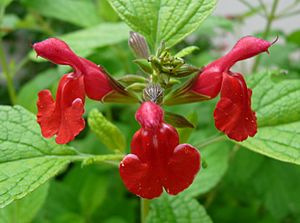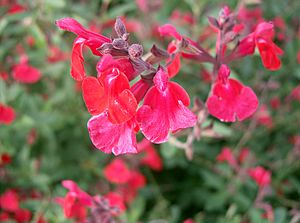Baby sage facts for kids
Quick facts for kids Baby sage |
|
|---|---|
 |
|
| Salvia microphylla 'Forever Red' | |
| Scientific classification | |
| Genus: |
Salvia
|
| Species: |
microphylla
|
| Synonyms | |
|
Salvia grahamii Benth. |
|
Salvia microphylla, also known as baby sage or blackcurrant sage, is a type of evergreen shrub. This plant grows naturally in southeastern Arizona and the mountains of Mexico. It is a very complex plant that easily mixes with other types of sage. This has led to many new kinds of Salvia microphylla being grown in gardens since the 1990s. The name microphylla comes from Greek words meaning "small leaved." In Mexico, people call it mirto de montes, which means "myrtle of the mountains."
Contents
What is Baby Sage Like?
Salvia microphylla plants usually grow to be about 1 to 1.3 meters (3 to 4 feet) tall and wide. They start blooming in their first year. They reach their full size in their second year. The leaves are shaped like an oval (ovate). They come in different sizes and can be smooth or have a few hairs.
When you crush the leaves, they have a strong smell. Some people say it smells nice, like mint. Others think it smells like blackcurrants. This is why it's also called "blackcurrant sage." This plant can sometimes spread underground. It forms thick patches of plants.
When Does Baby Sage Bloom?
Salvia microphylla and its many types bloom a lot in late spring. They also bloom again in autumn. If the weather is mild, they can even flower throughout the whole year. The flowers grow in groups called whorls. They come in many colors, like bright pink, red, and magenta.
How Scientists Name Baby Sage
A plant scientist named Carl Epling thought there were three main types of Salvia microphylla. These types grew in different places. But even today, it can be hard to tell them apart. There might even be more than three types.
It's also easy to confuse Salvia microphylla with another plant called Salvia greggii. This is because they often mix together and create new plants. Epling said you can tell them apart by their leaves. S. microphylla leaves have jagged edges. S. greggii leaves are narrow, oval, and have smooth edges.
Other Names for Baby Sage
In the U.S., Salvia microphylla is sometimes called "Graham's sage." This name came from George Bentham, who first called it Salvia grahamii. Another scientist, Merritt Lyndon Fernald, called it Salvia neurepia. But these names are not used anymore. This is because the name microphylla was given first.
There can also be confusion with Salvia lemmonii. This plant was named by Asa Gray. Later, Gray thought it was a type of S. microphylla. But most scientists still think S. lemmonii is its own unique plant. S. lemmonii has furry, pointed leaves that are about 1.5 to 3 cm (0.6 to 1.2 inches) long. Its flowers are often bright red or magenta.
Different Kinds of Baby Sage
Some types of Salvia microphylla are mixed with Salvia greggii. These are called Salvia × jamensis. Other types are mixed with different Salvia species. Together, these are sometimes called "Mexican salvias." They are evergreen shrubs. This means they keep their leaves all year.
These plants are not always strong enough to survive very cold weather. They also don't live for a very long time. However, it is easy to grow new plants from small pieces (cuttings).
- 'Alba': Has white flowers.
- 'Blush Pink': Has rich pink flowers.
- 'Cerro Potosi': Has large, bright magenta flowers.
- 'Desert Blaze': Has bright red flowers and leaves that are yellow and green.
- 'Forever Red': Is like a shrub and has long-lasting scarlet flowers.
- 'Graham's Sage': Has many red flowers that bloom at the same time.
- 'Hoja Grande': Has magenta-red flowers and dark green leaves.
- 'Hot Lips': Has flowers with a white bottom and a bright red top.
- 'James Compton': Has oval leaves with jagged edges and large, dark crimson flowers.
- 'Kew Red': Grows quickly and has bright red flowers.
- 'La Foux': Has deep crimson flowers with dark parts below the petals.
- 'La Trinidad Pink': Has bright pink flowers.
- var. neurepia (Fern.) Epling: Has cherry red flowers in autumn.
- 'Newby Hall': Grows 2 meters (6 feet) tall and has bright scarlet flowers.
- 'Oxford': Has dark pink flowers.
- 'Pat Vlasto' (S. × jamensis): Has smooth-edged leaves and peach-orange flowers.
- 'Pink Blush': Blooms a lot and has rose-magenta flowers.
- 'Pleasant View': Has pink flowers.
- 'Red Velvet': Has shiny red flowers.
- ‘Ribambelle’: Has many salmon pink flowers.
- 'Rosita': Blooms again and again with bright candy-pink flowers.
- 'Royal Bumble': Has large, deep crimson flowers on a bushy plant.
- 'Ruth Stungo': Has leaves that are green and white.
- 'San Carlos Festival': Has magenta-scarlet flowers and gray-green leaves.
- 'Trebah': Grows upright and has lilac white flowers.
- 'Trelawney': Grows upright and has rose-pink flowers.
- 'Trelissick': Grows upright and has creamy yellow flowers.
- 'Trenance': Grows upright and has lilac-pink flowers.
- 'Trewithin': Grows upright and has bright pink flowers.
- 'Wild Watermelon': Has large pink flowers with dark parts below the petals.
What is Baby Sage Used For?
In central Mexico, Salvia microphylla is grown as a plant for medicine. People use it to make tea.
See also
 In Spanish: Salvia microphylla para niños
In Spanish: Salvia microphylla para niños



